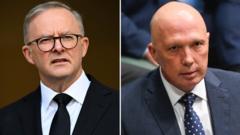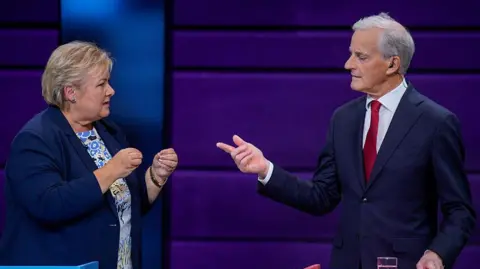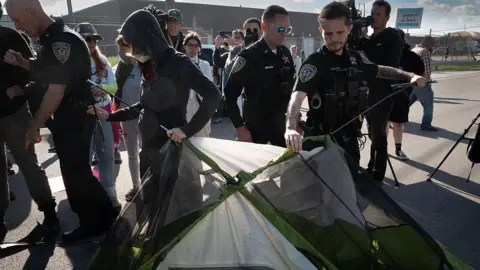Australia is poised to hold a significant federal election on May 3, as announced by Prime Minister Anthony Albanese following a visit to the Governor General in Canberra. The Labor Party, led by Albanese, will be defending a slender three-seat majority against the Liberal-National coalition's Peter Dutton.
With opinion polls indicating a narrow race between the two major parties, coalition partners may gain influence, possibly requiring alliances with independent or minor party members, particularly following their strong performance in the 2022 election. With a spotlight on pressing cost-of-living issues, the campaign is heating up as both sides seek to persuade voters.
Key topics on voters' minds include the affordability of housing and groceries, access to healthcare, and public safety concerns linked to crime rates and record immigration. Environmental issues remain vital for many Australians, too, as climate change continues to factor into political discussions.
Albanese is focused on solutions to the cost-of-living crisis, revealing plans aimed at increasing accessibility to healthcare through more complimentary doctor visits and proposing modest tax cuts. He argues that electing Dutton would hinder Australia’s progress.
In contrast, Dutton claims his party offers the necessary answers to voter concerns, vowing to “get Australia back on track,” particularly by adopting strict measures on crime and boosting economic performance.
Under the requirement that one of the major parties secures at least 76 of the 150 House of Representatives seats to claim a majority, the stage is set for a fiercely contested election.
Albanese, one of Australia’s longest-serving politicians, took office in 2022 amidst a backdrop of political instability that saw the country experience six leadership changes in eight years. He pledged a government prioritizing unity and integrity and has worked on ambitious climate policies such as instituting higher emissions reduction targets.
However, his government faces challenges such as the failed referendum regarding Bill support for Aboriginal and Torres Strait Islander constitutional recognition, alongside growing public discontent over economic conditions contributing to a cost-of-living crisis.
Dutton, with over two decades in Parliament, has cultivated a reputation as a staunch conservative, previously managing critical positions like health and immigration. Known for his hard-line stances, he is now attempting to soften his public image, distancing himself from past controversies while continuing to emphasize traditional values.
In Australia, voting is mandatory for adults, and historically, it has been a rare occurrence for a government to be ousted after just a single term since the 1930s. As the May election approaches, all eyes will be on how Australians choose to navigate this political landscape, particularly in a climate defined by uncertainty and urgency.
With opinion polls indicating a narrow race between the two major parties, coalition partners may gain influence, possibly requiring alliances with independent or minor party members, particularly following their strong performance in the 2022 election. With a spotlight on pressing cost-of-living issues, the campaign is heating up as both sides seek to persuade voters.
Key topics on voters' minds include the affordability of housing and groceries, access to healthcare, and public safety concerns linked to crime rates and record immigration. Environmental issues remain vital for many Australians, too, as climate change continues to factor into political discussions.
Albanese is focused on solutions to the cost-of-living crisis, revealing plans aimed at increasing accessibility to healthcare through more complimentary doctor visits and proposing modest tax cuts. He argues that electing Dutton would hinder Australia’s progress.
In contrast, Dutton claims his party offers the necessary answers to voter concerns, vowing to “get Australia back on track,” particularly by adopting strict measures on crime and boosting economic performance.
Under the requirement that one of the major parties secures at least 76 of the 150 House of Representatives seats to claim a majority, the stage is set for a fiercely contested election.
Albanese, one of Australia’s longest-serving politicians, took office in 2022 amidst a backdrop of political instability that saw the country experience six leadership changes in eight years. He pledged a government prioritizing unity and integrity and has worked on ambitious climate policies such as instituting higher emissions reduction targets.
However, his government faces challenges such as the failed referendum regarding Bill support for Aboriginal and Torres Strait Islander constitutional recognition, alongside growing public discontent over economic conditions contributing to a cost-of-living crisis.
Dutton, with over two decades in Parliament, has cultivated a reputation as a staunch conservative, previously managing critical positions like health and immigration. Known for his hard-line stances, he is now attempting to soften his public image, distancing himself from past controversies while continuing to emphasize traditional values.
In Australia, voting is mandatory for adults, and historically, it has been a rare occurrence for a government to be ousted after just a single term since the 1930s. As the May election approaches, all eyes will be on how Australians choose to navigate this political landscape, particularly in a climate defined by uncertainty and urgency.




















